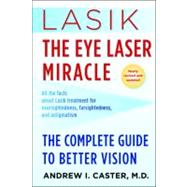
| Introduction | p. xi |
| Basic Information-Everyone Should Read This | |
| The Treatment Is Easy | p. 3 |
| How Does the Eye Work? | p. 6 |
| Common Vision Problems | p. 8 |
| How Does Laser Treatment Improve Vision? | p. 13 |
| Are You a Good Candidate? | p. 16 |
| The Pretreatment Consultation | p. 18 |
| Flap or No Flap? | p. 22 |
| What Does Custom Wavefront Treatment Mean? | p. 26 |
| The Treatment Experience: The Patient's Perspective | p. 28 |
| Recovery After Lasik | p. 34 |
| Recovery After PRK | p. 37 |
| How Well Will You See? | p. 42 |
| The Healing Response: The Big Variable | p. 45 |
| Complications: What Can Go Wrong? | p. 48 |
| Re-treatments | p. 56 |
| One Eye or Two? | p. 59 |
| How to Choose a Doctor | p. 62 |
| If You Are Over Thirty-five | p. 65 |
| The Most Commonly Asked Questions About Laser Vision Correction | p. 73 |
| Additional Information-for Those Who want to Know More | |
| What Does "20/20" Mean? | p. 81 |
| What Is a Laser? What Is an Excimer Laser? | p. 86 |
| The History of Laser Vision Correction | p. 89 |
| Who Monitors This Technique? The Role of the FDA | p. 93 |
| Five Important Tests-and What They Mean | p. 95 |
| Alternatives to Laser Vision Correction | p. 101 |
| Intraocular Lenses | |
| Conductive Keratoplasty (CK) | |
| Corneal Rings (Intacs) | |
| Radial Keratotomy (RK) | |
| Automated Lamellar Keratoplasty (ALK) | |
| Orthokeratology | |
| Glasses and Contact Lenses | |
| No More Reading Glasses? | p. 111 |
| Afterword | |
| My Own Experience as a Patient | p. 117 |
| Appendixes | |
| Other Sources of Information | p. 125 |
| Glossary | p. 127 |
| Acknowledgments | p. 137 |
| Index | p. 139 |
| Table of Contents provided by Ingram. All Rights Reserved. |
The New copy of this book will include any supplemental materials advertised. Please check the title of the book to determine if it should include any access cards, study guides, lab manuals, CDs, etc.
The Used, Rental and eBook copies of this book are not guaranteed to include any supplemental materials. Typically, only the book itself is included. This is true even if the title states it includes any access cards, study guides, lab manuals, CDs, etc.
Excerpted from Lasik: The Eye Laser Miracle by Andrew I. Caster
All rights reserved by the original copyright owners. Excerpts are provided for display purposes only and may not be reproduced, reprinted or distributed without the written permission of the publisher.